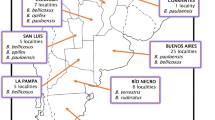Abstract
Rogas lymantriae Watanabe was reared onLymantria dispar (L.) for 125 generations in the laboratory following importation from Japan. No deleterious effects of colonization were observed and one measured parameter, successful parasite emergence, significantly improved over time. Decreased density of the host or conspecific female parasites resulted in higher levels of parasitism and numbers of females in the next generation. During 3 different years, colony production was significantly increased with little difficulty to provide parasites for inoculative releases in the field.
Résumé
Depuis son importation du Japon,Rogas lymantriae a été élevé surLymantria dispar (L.), en laboratoire durant 125 générations. Aucun effet néfaste n'a été observé et le paramètre mesuré: le succès de l'émergence du parasite, s'améliorait d'une manière significative chaque fois. Une densité croissante de l'hôte ou des parasites femelles conspécifiques avait pour résultat des niveaux plus élevés de parasitisme et du nombre de femelles dans la génération suivante.
Durant trois années différentes, la production augmentait d'une manière significative avec peu de difficulté pour produire les parasites nécessaires aux lâchers inoculatifs dans les champs.
Similar content being viewed by others
References
Anderson, J. Hoy, M. A. &Weseloh, R. M. — 1977. Field cage assessment of the potential for establishment ofRogas indiscretus against gypsy moth. —Environ. Entomol., 6, 375–380.
Hoy, M. A. — 1976. Establishment of gypsy moth parasitoids in North America: an evaluation of possible reasons for establishment or non-establishment. In: Perspectives in Forest Entomology (J. F. Anderson &H. K. Kaya, eds.). —Acad. Press, New York, 215–232.
Hoy, M. A. — 1978. Variability in diapause attributes of insects and mites: Some evolutionary and practical implications. In: Evolution of insect migration and diapause (H. Dingle, ed.). —Springer Verlag, New York, 101–126.
Huffaker, C. B. Messenger, P. S. &DeBach, P. — 1974. The natural enemy component in natural control and the theory of biological control. In: Biological control (C. B. Huffaker, ed.). —Plenum, New York, 16–62.
King, B. H.; — 1987. Offspring sex ratios in parasitoid wasps. —Quar. Rev. Biol., 62, 367–396.
Muesebeck, C. F. & Dohanian, S. M. — 1927. A study in hyperparasitism with particular reference to the parasites ofApanteles melanoscelus (Ratzeburg). —U.S. Dep. Agric. Bull., 1487.
Odell, T. M. &Rollinson W. D. — 1966. A technique for rearing the gypsy moth,Porthetria dispar (L.), on artificial diet. —J. Econ. Entomol., 59, 741–747.
Reardon, R. C., Statler, M. W. &McLane, W. H. — 1973. Rearing techniques and biology of five gypsy moth parasites. —Environ. Entomol., 2, 124–127.
Turnbull, A. L. — 1967. Population dynamics of exotic insects. —Bull. Entomol. Soc. Am., 13, 333–337.
Van den Bosch, R. — 1968. Comments on population dynamics of exotic insects. —Bull. Entomol. Soc. Am., 14, 112–115.
Wallner, W. E. — 1979. Induction of diapause inRogas indiscretus, a larval parasite of the gypsy moth,Lymantria dispar. —Ann. Entomol. Soc. Am., 72, 358–360.
Wallner, W. E., Dubois, N. R. &Grinberg, P. S. — 1983. Alteration of parasitism byRogas lymantriae [Hymenoptera: Braconidae] inBacillus thuringiensis-stressed gypsy moth [Lepidoptera: Lymantriidae] hosts. —J. Econ. Entomol., 76, 275–277.
Watt, K. E. F. — 1965. Community stability and the strategy of biological control. —Can. Entomol., 97, 887–895.
Weseloh, R. M., Wallner, W. E. &Hoy, M. A. — 1979. Possible deleterious effects of releasingAnastatus kashmirensis, a facultative hyperparasite of the gypsy moth. —Environ. Entomol., 8, 174–177.
Author information
Authors and Affiliations
Rights and permissions
About this article
Cite this article
Grinberg, P.S., Wallner, W.E. Long-term laboratory evaluation ofRogas lymantriae: A braconid endoparasite of the gypsy moth,Lymantria dispar . Entomophaga 36, 205–212 (1991). https://doi.org/10.1007/BF02374556
Received:
Accepted:
Issue Date:
DOI: https://doi.org/10.1007/BF02374556




